
Edith Minturn Sedgwick Post was an American actress, model, and socialite, who was one of Andy Warhol's superstars, starring in several of his short films during the 1960s. Her prominence led to her being dubbed an "It Girl", while Vogue magazine named her a "Youthquaker".
Warhol superstars were a clique of New York City personalities promoted by the pop artist Andy Warhol during the 1960s and early 1970s. These personalities appeared in Warhol's artworks and accompanied him in his social life, epitomizing his dictum, "In the future everyone will be famous for fifteen minutes". Warhol would simply film them, and declare them "superstars".

Jackie Curtis was an American actor, writer, singer, and Warhol superstar.

The Factory was Andy Warhol's studio in New York City, which had four locations between 1963 and 1987. The Factory became famed for its parties in the 1960s. It was the hip hangout spot for artists, musicians, celebrities and Warhol's superstars. The original Factory was often referred to as the Silver Factory. In the studio, Warhol's workers would make silkscreens and lithographs under his direction.

Gerard Joseph Malanga is an American poet, photographer, filmmaker, actor, curator and archivist.

Joseph Angelo D'Allesandro III is an American actor and Warhol superstar. He was a sex symbol of gay subculture in the 1960s and 1970s, and of several American underground films before going mainstream.

Candy Darling was an American transgender actress, best known as a Warhol superstar. She starred in Andy Warhol's films Flesh (1968) and Women in Revolt (1971), and was a muse of the Velvet Underground.
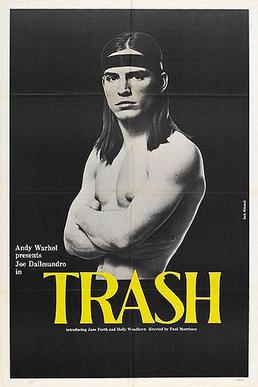
Trash is a 1970 American drama film directed and written by Paul Morrissey and starring Joe Dallesandro, Holly Woodlawn and Jane Forth. Dallesandro had previously starred in several other Andy Warhol/Paul Morrissey films such as The Loves of Ondine, Lonesome Cowboys, San Diego Surf, and Flesh.

Holly Woodlawn was a transgender American actress and Warhol superstar who appeared in the films Trash (1970) and Women in Revolt (1971). She is also known as the Holly in Lou Reed's hit glam rock song "Walk on the Wild Side".
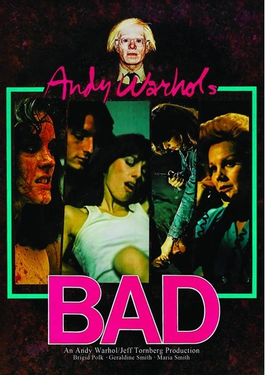
Bad, also known as Andy Warhol's Bad, is a 1977 comedy film directed by Jed Johnson and starring Carroll Baker, Perry King, and Susan Tyrrell. It was written by Pat Hackett and George Abagnalo, and was the last film produced by Andy Warhol before his death in 1987.

Flesh for Frankenstein is a 1973 horror film written and directed by Paul Morrissey. It stars Udo Kier, Joe Dallesandro, Monique van Vooren and Arno Juerging. Interiors were filmed at Cinecittà in Rome by a crew of Italian filmmakers.
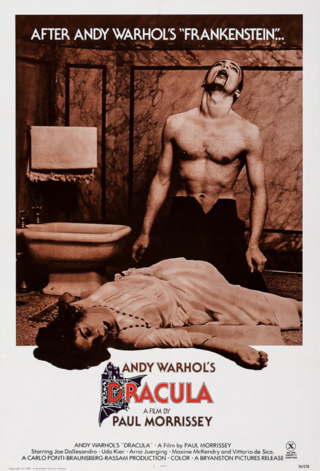
Blood for Dracula is a 1974 horror film written and directed by Paul Morrissey, and starring Udo Kier, Joe Dallesandro, Maxime McKendry, Stefania Casini, Arno Juerging and Vittorio de Sica. Upon its initial 1974 release in West Germany and the United States, Blood for Dracula was released as Andy Warhol's Dracula.
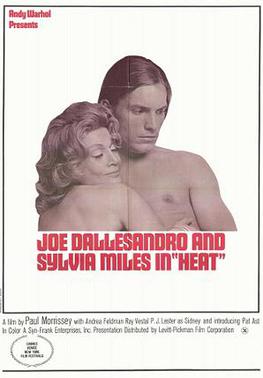
Heat is a 1972 American comedy drama film written and directed by Paul Morrissey, produced by Andy Warhol, and starring Joe Dallesandro, Sylvia Miles and Andrea Feldman. The film was conceived by Warhol as a parody of the 1950 film Sunset Boulevard. It is the final installment of the "Paul Morrissey Trilogy" produced by Warhol, following Flesh (1968) and Trash (1970).
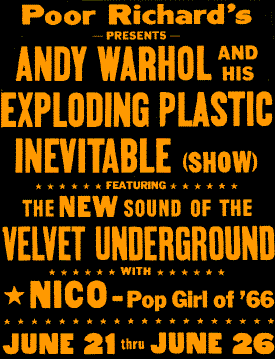
The Exploding Plastic Inevitable, sometimes simply called Plastic Inevitable or EPI, was a series of multimedia events organized by Andy Warhol and Paul Morrissey in 1966 and 1967, featuring musical performances by The Velvet Underground and Nico, screenings of Warhol's films, and dancing and performances by regulars of Warhol's Factory, especially Mary Woronov and Gerard Malanga. Andy Warhol's Exploding Plastic Inevitable is also the title of an 18-minute film by Ronald Nameth with recordings from one week of performances of the shows which were filmed in Chicago, Illinois, in 1966. In December 1966 Warhol included a one-off magazine called The Plastic Exploding Inevitable as part of the Aspen No. 3 package.

Susan Dunn Whittier Bottomly, also known as International Velvet, is a former American model and actress. She is known primarily for her appearances in many of Andy Warhol's underground films, as well as her modeling career which spanned over a decade.
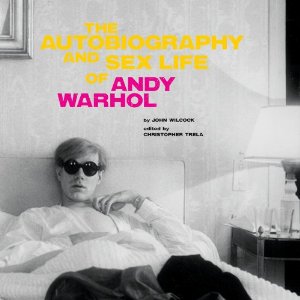
The Autobiography and Sex Life of Andy Warhol (ISBN 978-0-9706126-1-8) is a 1971 book by the British journalist John Wilcock. It was republished in June 2010 by Trela Media.
Geraldine Smith is an American actress.

My Hustler is a 1965 American drama film by Andy Warhol and Chuck Wein. Set on Fire Island, My Hustler depicts competition over the affections of a young male hustler among a straight woman, a former male hustler, and the man who hired the boy’s companionship via a “Dial-A-Hustler” service.

The Garrick Cinema was a 199-seat movie house at 152 Bleecker Street in the Greenwich Village neighborhood of Lower Manhattan in New York City. Andy Warhol debuted many of his notable films in this building in the late 1960s. Frank Zappa and the Mothers of Invention played here nightly for 6 months in 1967.
























